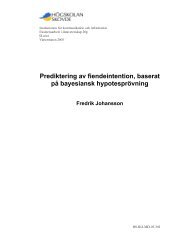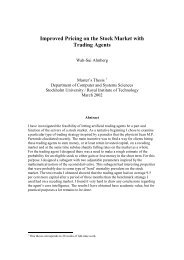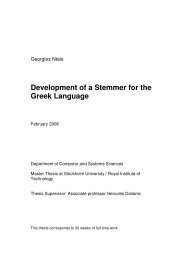Modeling Hydra Behavior Using Methods Founded in Behavior-Based Robotics
Modeling Hydra Behavior Using Methods Founded in ... - SAIS
Modeling Hydra Behavior Using Methods Founded in ... - SAIS
Create successful ePaper yourself
Turn your PDF publications into a flip-book with our unique Google optimized e-Paper software.
Chapter 6Models and methodsIn this thesis the overall behavior of <strong>Hydra</strong> is modeled by def<strong>in</strong><strong>in</strong>g <strong>in</strong>dividual behaviors,as well as a behavioral organizer for coord<strong>in</strong>ation of those behaviors. The model of <strong>Hydra</strong>aimes at describ<strong>in</strong>g the behavior of the animal as functions of its motivational state. Forthe <strong>in</strong>itial purpose of validat<strong>in</strong>g the behavioral model, a simulated system was developed.Also, once a behavioral model has been validated, such a system can be used to predictthe behavior of the animal <strong>in</strong> various environmental set-ups. In this project, however,the simulated system was only used for validation experiments, as discussed <strong>in</strong> Section7.2. This chapter starts with a description of the simulated system, and concludes bypresent<strong>in</strong>g the methods used for generat<strong>in</strong>g and organiz<strong>in</strong>g the behaviors of <strong>Hydra</strong>.6.1 The simulated system<strong>Hydra</strong> was modeled ignor<strong>in</strong>g the dynamical properties of its body. It should be notedthat, as po<strong>in</strong>ted out e.g. <strong>in</strong> [10, 12], the body of an animal is <strong>in</strong>deed connected to itsbehavior. Thus, this simplification was made not because the properties of <strong>Hydra</strong>’s bodyare unimportant for its behavior, but rather <strong>in</strong> an attempt to isolate, as much as possible,and focus on the behavioral traits <strong>in</strong> this first work towards a behavioral model of theanimal. Also, the time aspect of this project was a factor <strong>in</strong> mak<strong>in</strong>g this simplification.As will be discussed <strong>in</strong> Chapter 8, an expansion of the model to <strong>in</strong>clude a more realisticmorphology of <strong>Hydra</strong> might very well be a task for future work.In this simplified model of <strong>Hydra</strong>, the animal’s body is represented <strong>in</strong> 2D, by a circlewith radius r and maximum extension length l max . The movement of the animal is controlledsimply by sett<strong>in</strong>g the correspond<strong>in</strong>g states directly, which is described <strong>in</strong> Section6.1.1. The physical state variables describ<strong>in</strong>g the body of the simulated <strong>Hydra</strong> is given <strong>in</strong>Table 6.1. In the 2D model of <strong>Hydra</strong>, the position of the animal’s hypostome, rather thanof its foot, was taken as the <strong>in</strong>terface to (the simulated) environment. While this approach19





